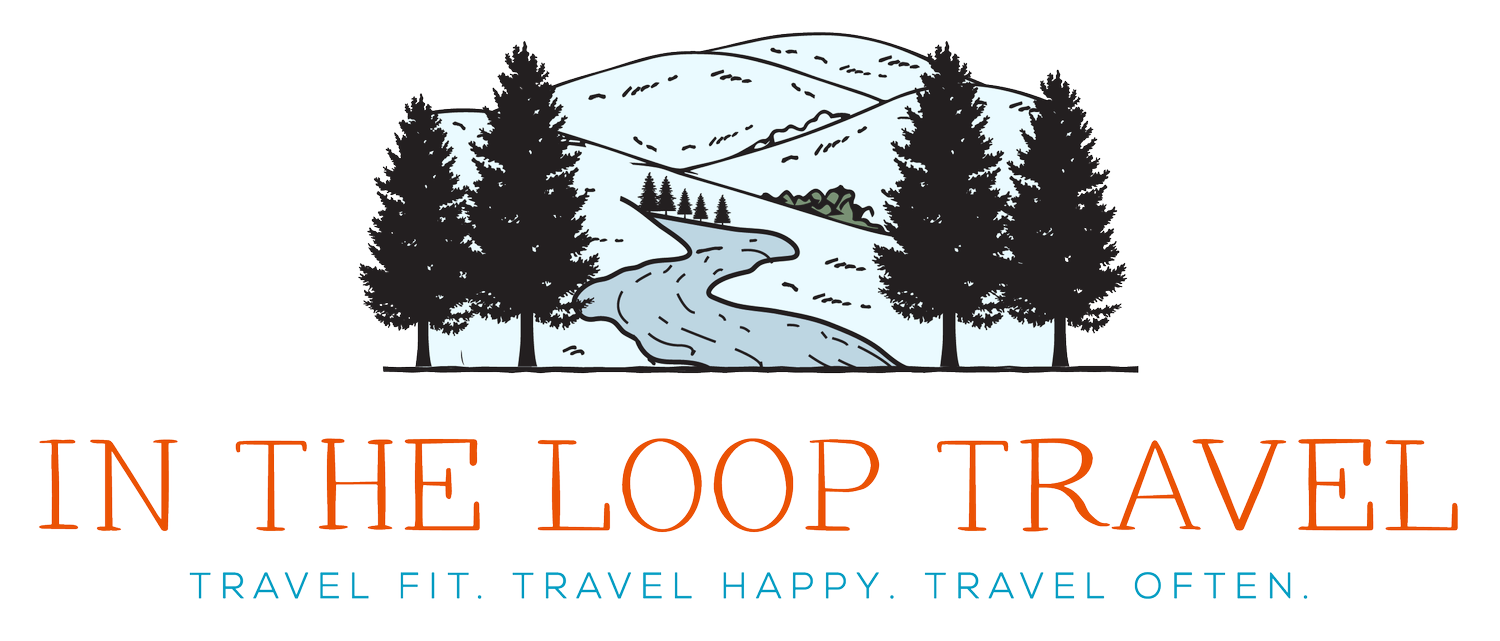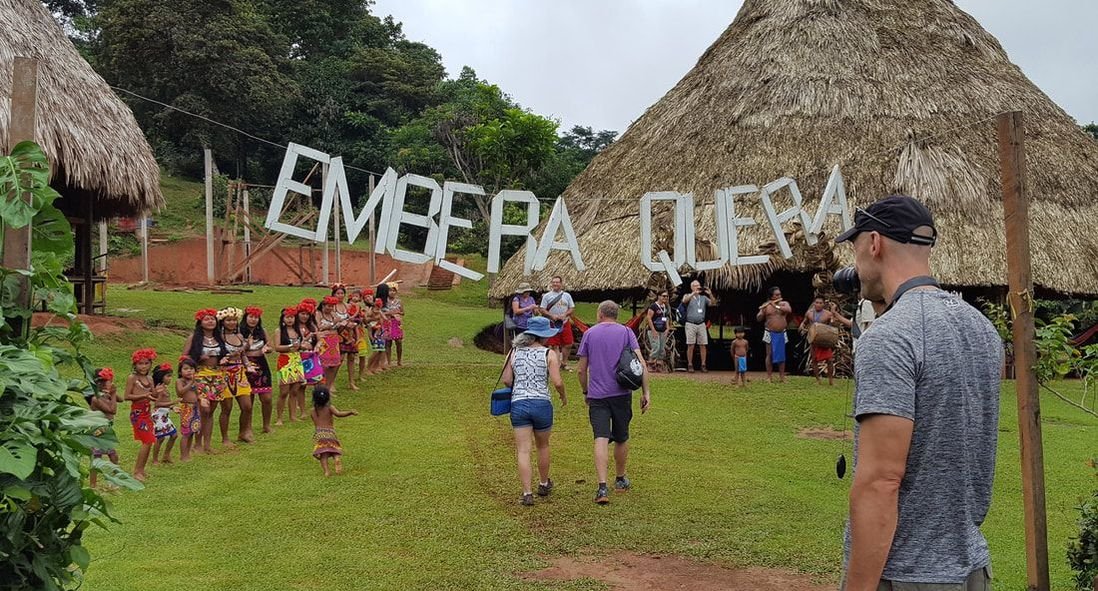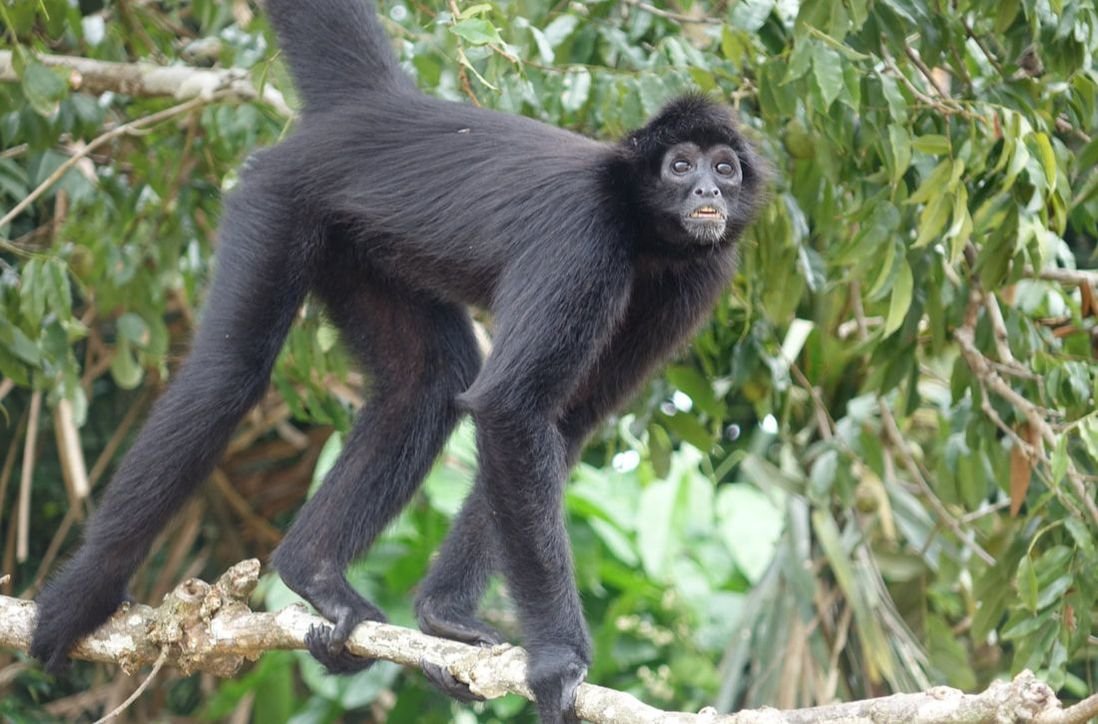UnCruise’s Spectacular Jungle Cruise in Costa Rica and Panama
One of our first stops brought us to the Embera Quera Village in Panama to meet the indigenous people of this region.
Linking arms and hands, our group of six hikers was able to safely cross the rapidly flowing stream. A small footbridge had long been washed away, and the rain storm made the waters race down the hillside with increased pace this afternoon. With our shoes now completely drenched, we continued scrambling along the muddy trail in Costa Rica's Osa Conservation Area. The animals we had hoped to spot stayed hidden away during the heavy afternoon rains. They were up there somewhere, I imagined, watching this strange pack of people below who don't have enough sense to huddle away during such conditions.
What's it like to spend time in the wilds in one of the most biodiverse and pristine parts of the world? That's just what I had aimed to find out during our voyage with UnCruise Adventures in Panama and Costa Rica. And this hike was giving us the full sense of the raw, lush, beautiful, mysterious and often unforgiving conditions that serve as home to a staggering number of the world's animal and plant varieties.
I had been to Costa Rica and Panama a couple times before, but only on short stops — one-day port visits with other cruise lines. This gave me a nice sampling of these amazing places, but UnCruise puts the region on full display, unveiling its fascinating rainforests, coastlines and vast array of creatures during its journeys on Safari Voyager, the 62-passenger ship purpose-built for this itinerary.
Our journey starts in Panama City, and we board the ship in Shelter Bay Marina. To escape civilization, we will be transiting the Panama Canal. Shelter Bay is our base for a day as we first venture into Gatun Lake and up a river on small boats to meet indigenous people living in their village in the remote country. Embera Quera is a commune of sorts, with about 50 people living as one large family led by a chief away from the Panamanian government on wilderness land they have purchased. They support themselves by hosting visitors (day trips or overnight lodging is available) and selling crafts.
It's a fun experience to visit with people live simple and uncluttered lives. We engaged in a discussion and presentation on how they live, as well as enjoy songs and dances. We then were encouraged to join in, and many of us paired up with our Embera partners to sway and spin around the hard-packed dirt floor under the large open-air, thatched-roof of the central meeting building. Imagine a 6-foot-4 white Westerner pirouetting with a barely 5-foot-tall brown native girl. We all had a blast and were also given a homemade tilapia and plantain snack that was served up in large palm leaves.
We capped our trip to the rustic village by purchasing a memento of our visit: a pair of sloths (mom and child) hand carved from a tagua seed. While riding into and out of the village on our motorized narrow dugout canoes, we spotted our first wildlife, too. An active spider monkey gave us a show in the trees at the edge of a lake, and we also saw a small crocodile and several turtles. It was early on during the adventure, but you could already see fellow cruisers beginning to bond with one another. It seems that singing and dancing with friendly native people in a gorgeous fresh-air natural setting and spying active and exotic animals from the cramped confines of a wooden boat is an ideal way to turn perfect strangers into fast friends.
We were fortunate to see this howler monkey at Fort San Lorenzo. These monkeys are typically shy.
The next morning before setting sail on Safari Voyager, we went on a hike at St. Lorenzo Fort, which is a UNESCO World Heritage site just six miles from Shelter Bay. The fort sits at the mouth of the Chagres River, and we saw howler monkeys in the trees just at the edge of the property. We didn't have to take many steps on our trail before we saw a sloth, more monkeys, humming birds, colorful flowers, butterflies and a massive termite nest — our guide Erika even persuaded us to eat a few live termites to experience some "survival skills." (The sweet pine-flavored bugs are pretty tasty, by the way.)
The trip was off to a good start.
An Expedition Cruise is the Best Way to See the Panama Canal
Ship Life
UnCruise Adventures refurbished Safari Voyager and relaunched the ship in early 2017. The four-deck vessel is comfortable, with a spacious lounge and several pleasant outdoor spaces with seating. These areas are where passengers spend most of their time on the ship. The bar (drinks are all included on Safari Voyager) is in the lounge, and you also meet here for daily chats about the upcoming schedule of events for your voyage as well as for after-dinner enrichment talks on subjects such as mangroves or primates. The lounge features a small library of DVDs (cabins have TVs with DVD players) and a selection of games to keep you occupied and help you get acquainted with other passengers. Many on our cruise had fun putting together a large puzzle.
The food is also a highlight on this trip. Breakfasts, lunches and dinners were all outstanding, featuring fresh-made meals that are locally sourced and highlight the traditional flavors of the region. Dinner menus offer a meat, fish and vegetarian dish each night. It’s also common for people to choose a half-and-half plate if they can’t decide between two delicious-sounding options.
At 3 p.m. each day, it's "Cookie Hour" with some of the best-tasting cookies I've ever had. We had chocolate chip, oatmeal raisin, peanut butter, chocolate chip mint and snickerdoodles. Passengers constantly raved about the pastries, brownies, breads and other sweets throughout the week.
Safari Voyager has a viewing platform on the front of Deck 2 and a small bench to use on Deck 3 in front of the bridge. The captain welcomes visitors into the bridge at most any time to see how the ship operates. The sports marina is at the back of the ship and is used for launching the daily excursions via kayak or skiff boat. A nice seating area is on Deck 3 aft, and the crew served a barbecue dinner outside there as we began our voyage sailing through the Panama Canal. It was an incredible experience to be enjoying dinner inside a canal lock on a sunny day as we watched the workers onshore throwing ropes to the ship and guiding us through the system.
This Deck 3 outside area is also the space for early-morning stretch and yoga sessions led by the Safari Voyager wellness staff. Spin bikes, an elliptical machine and set up free-weights are also located in this area for morning workouts. The ship has two massage rooms, and each passenger is entitled to a 30-minute massage during the cruise (included in your fare).
Basic cabins are tight for two people, but the space is well thought out with smart nooks and areas for placing all your clothes, gear and camera equipment you will be using. It rains a lot in this region, and you'll probably encounter heavy, long periods of downpours. The ship offers a dryer and clothes spinner to help wring out the wetness from your clothing.
Rainforests, Beaches and Animals
The food is wonderful, and the drinks and amenities are fabulous bonuses and add to an overall fantastic expedition. But the main draw for this journey is what is off the boat. After transiting the canal, we arrived to the Pacific Coast of Panama. Granito de Oro (Little Grain of Gold) is our destination, and the tiny island has the best snorkeling we have enjoyed outside of the southern Caribbean.
The island is part of the protected Coiba Island National Park region, and we spent the day there. In the morning, we headed to the tiny island beach. Safari Voyager cruisers get the oasis to themselves for a couple hours before other tour boats arrive. The island looks as if it was made for postcards. One prominent palm tree sits in the center of the beach, back near the tree line, and the sands are crawling with our welcoming committee — thousands and thousands of hermit crabs.
We gear up, slide into the water and begin to snorkel around the island. We make a complete circumnavigation of Granito de Oro, and schools of fish encircle us frequently in the clear waters. We also spot several turtles: greens and Hawksbills. The snorkeling experience is delightful here, and even a few small stings from tiny jellyfish didn't ruin the day. The jellies were invisible to us, causing a brief shock, but we finished our swim with no problem. UnCruise deploys guides and kayakers to keep watch over snorkel groups and will get you out of the water if you feel at all uncomfortable.
We finish our circumnavigation of the island, a little tired and thoroughly satisfied in what we've seen. I race to the cooler ashore that's packed with drinks and return with several beers to share with my fellow snorkelers as we compare notes on turtles, fish and coral and wade in the warm waters. We sipped from cold cans of Balboa lager. And gazing at the surrounding views, you wouldn't be able to convince any of us that this isn't paradise.
Several in our group were snorkeling for the first time and had a blast. However, I'm afraid having your first snorkel experience at Granito de Oro might lead unrealized expectations for when you go snorkeling again at most other places in the world.
Passengers also jumped into kayaks and onto stand-up paddleboards to have fun in the waters. For the afternoon, Safari Voyager repositioned to the main Coiba Island, the largest island in Central America. We had lunch ashore and took a nature walk, which led to a spectacular set of monkey encounters. We could hear a monkey making a ruckus in a nearby tree as we ate our lunch, and we found him early on the path into the forest.
Iguana Island in Panama was one of several exotic and remote getaways we were able to enjoy on our trip.
Our UnCruise Adventures expedition guide Rey told us this guy was an alpha-male Coiba Island Howler, the only place in the world to see this species, which is a smallish howler with reddish-brown coloring on its fur.
Then, just a few paces away from where we had lunch at picnic tables, a troop of white-face capuchins came onto the lawn. This species is much bolder, and the tribe we encountered was obviously used to visitors to the island. Several of the monkeys picked over fallen coconuts, reaching into them for insects and scrounging the edge of the trees for nuts and other food. We could have watched them for hours, but soon it was time to head back to Safari Voyager. Cookie Hour was approaching, after all.
We headed to bed early to prepare for a pre-dawn wakeup on our first day in Costa Rica. Safari Voyager left Panama and headed to Golfito, a small fishing village and bay in Costa Rica. We woke to view low-hanging clouds in the hillside (cloud forest) and loaded into skiffs to explore the bay and mangroves at sunrise. Mangroves are an under-appreciated forest formation that provide a sanctuary for all kinds of birds and mammals and are a nursery area for crocodiles, shellfish, fish and crabs.
They also offer protection for coastlines from storms and prevent erosion. We spotted many birds and a few monkeys active high in the trees nearby. We simply reveled in the quiet calmness of the early morning on the waterway.
The ship cruised up the coast to reach Piedras Blancas National Park, where groups chose to go ashore for a rainforest hike or yoga at an ecolodge. We opted to go kayaking. It was raining, so our hearty batch of paddlers thought "why not just go out on the water?" We hoped to see a crocodile or two, but we settled for more birds and two hours of active paddling. We had only one full day left ahead of us on the voyage, and it seemed like we were just getting started. Time really flies when you are immersed in such an interesting and enlightening part of the world and able to get off the grid and commune with nature.
Safari Voyager arrived in Peninsula de Oso on Day 6 to place us right in the heart of perhaps the most biodiverse location on the planet. Things were crackling from the moment we stepped off our skiffs at a beach upon arriving in the morning. Passengers zigzagged on paths along the edge of rainforest, exchanging details and directions about where they spotted baby monkeys in the trees or birds such as toucans and macaws.
Sheridan, a biologist on vacation from Colorado, came back to the beach after her walk and gave us perfect directions to a spot in a clearing where we were able to see two colorful scarlet macaws perched comfortably on a branch.
There was time for beers, sodas, snacks and swimming, too. The picturesque beach is framed by jagged volcanic rock formations jutting from the sea. It's a true nature-lover's paradise. We had lunch on the ship and then more activities to take on. The afternoon excursion took us to another spot in the rainforest after the ship had relocated. Rains poured on us during the first hour of our rainforest hike, and the animals had disappeared to take shelter.
Still, we found ourselves thoroughly enthralled as we trudged into the hills along a muddy path as red-clay colored waters flowed as tiny rivers beneath our feet and the lush green forest enveloped our group. The sounds of rains hitting the leaves and rushing waters was a delightful rainforest symphony.
Colleen noted how surprised she was to be having a fun time hiking in a rain storm — shortly after our group had successfully joined hands to traverse that stream.
Then, our patience and persistence in braving these jungle conditions paid off. The rains slowed to a gentle mist, and the animals started to emerge. First a troop of capuchins scurried around overhead, hungry and active after waiting out the storm. Branches, leaves and fruits tumbled to the forest floor. (Were they throwing them at us?)
We could hear the raging waterfall just ahead, our ultimate destination on the hike. Reaching another wonderfully scenic landmark, we gathered together to snap a group picture as a fitting way to cap our amazing week with UnCruise Adventures.
Thanks for having a read!
Happy travels,
JR














